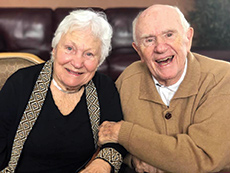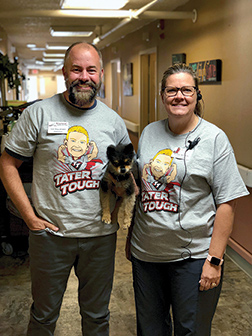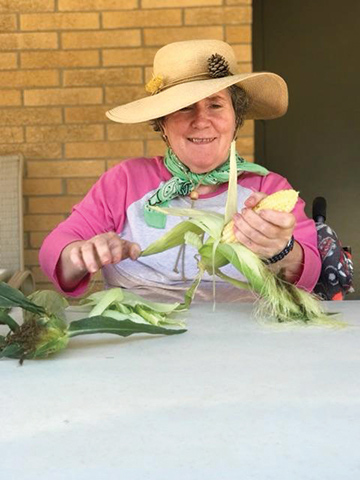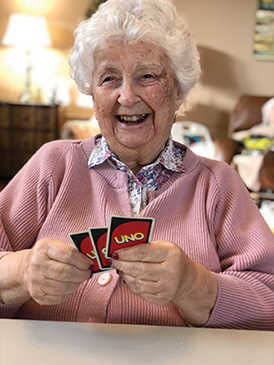During an onsite study of end-of-life care a few years ago, a researcher heard a comment from a nursing center resident that gave her a new perspective. She was part of a team collecting data in the center by interviewing residents, staff, and family members.
She took a break to sit among residents watching TV and listened to their conversation. Then one of the residents asked her what she was doing there. After explaining that she was collecting information about resident experiences as end of life approaches, one of the residents said, “Why do we have to be dying to have someone interested in improving our lives?”
Today, meeting residents’ social and emotional needs in long term and post-acute care (LT/PAC) is considered fundamental in culture change and person-centered care. The providers that take a serious approach to meeting these needs embrace the time, space, and action needed to recognize and investigate changes in residents’ emotional states.
These changes may arise from a slight change in plans for the day or from a more dramatic change in life circumstances, which is common in LT/PAC. The rewards of such an approach play out in resident satisfaction surveys, a lower instance of complaints, and, most importantly, a higher quality of life.
Paying Attention
The story above comes from Mercedes Bern-Klug, PhD, who has been in the aging field for the past 30 years. At the age of 18 she joined AARP and began reading Modern Maturity from cover to cover. Currently she is professor at the School of Social Work and director, Aging & Longevity Studies Program, at the University of Iowa in Iowa City, Iowa.
Bern-Klug outlines her experience in a 2018 editorial for JAMDA, the official journal of AMDA—The Society for Post-Acute and Long-Term Care Medicine, and details a similar conversation with a family member who asked Bern-Klug where she was when her mother was first admitted to the skilled nursing center during a medical crisis.
The residents had a point, Bern-Klug says. “The problem is that we were not paying enough attention to these individuals earlier in their lives. In other words, we were not paying attention to their psychosocial needs.”
Defining Psychosocial

According to a 2005 report from the Institute for the Advancement of Social Work Research titled, “Evaluating Social Work Services in Nursing Homes: Toward Quality Psychosocial Care and Its Measurement,” the term “psychosocial” refers to an array of social and emotional needs and the care provided to meet them.
Social and emotional needs may be related to mental health disorders such as depression, anxiety, dementia, and delirium, all measured by the Minimum Data Set (MDS).
Psychosocial care also addresses social and emotional needs with a more obvious social dimension, including loss of relationships, loss of personal control and identity, adjustment to the facility, continuity of care, and end-of-life care, according to the report.
A Bridge
“When we’re talking about psychosocial, we’re talking about good quality of care and good quality of life,” says Bern-Klug. “It bridges those two concepts. And so any issue that comes up as a nursing issue or medical issue has psychosocial implications.”
For example, consider a resident who newly suffers from incontinence. On the resident’s part, there may be shame and embarrassment and an adjustment to needing someone else’s assistance. “That’s not just about a nursing issue, it’s a psychosocial issue,” says Bern-Klug. Anything that affects how people feel about themselves or their relationship with other people is a psychosocial issue, she says. “It’s something we can respect and honor and work to enhance.”
Psychosocial issues may arise any time a resident has a new diagnosis or a serious exacerbation of a health condition, or even if a resident gets better. “Any of these changes can affect people emotionally and affect their sense of who they are and what they’re going through,” says Bern-Klug. “Providers should pay attention to those changes and honor them and give residents a place to discuss these changes, even informally.”
And that’s where the direct care staff can come in. A center’s social worker can’t be every place at every time, says Bern-Klug. “Somebody is putting lotion on someone’s hands and helping them put on their shoes,” she says. “They have been psychosocially prepared to interact with residents. They can engage in conversations or even listen to what residents have to say in a way that honors the experience that that person is going through. And we just don’t always think about how we do that.”
Something Extra
To see quality psychosocial care in action, look no further than Briarwood Health Care Center in Iowa City, Iowa, says Bern-Klug. It’s here that staff keep an eye on residents’ psychosocial health by taking their social and emotional needs seriously.

Briarwood decided to take a deeper approach to psychosocial care five years ago. While most of the staff came from small towns where everyone knew everyone else, Administrator Andy Maas and his staff realized that the comforting feeling that comes with that was missing at Briarwood. So they got everyone more acquainted.
“We decided to ask more questions early on during admission,” says Maas. “Our goal was to know the residents more on a personal level, so we’d ask them questions like what their previous job was. We’d ask them not just where they worked and what they did but what they enjoyed about it.”
The nurse admitting the residents asked questions not just related to their medical diagnosis, but how they were feeling emotionally. The certified nurse assistants (CNAs) that would care for the residents were also introduced immediately and got to know them early.
Maas says staff have kept this approach going to today. “When someone comes into the facility, I want someone from every department to meet with them, talk to them, get to know them within the first 24 hours of them being in the building,” he says. What comes next is make all the frontline staff, including CNAs, activity staff, and so on, aware of the resident’s information so that they are better prepared to help meet the residents’ emotional needs.
End-of-Life Transitions
Extra time and attention are what it takes to be aware of residents’ and patients’ psychosocial needs, says Maas. Extra effort is what it takes to meet them.
Staff keep an extra eye on residents going through life changes. Recently, a resident’s grandson had passed away, and a group of staff members decided to spend an extra 45 minutes to an hour each day with the resident.
“They wanted to make sure they had the time to see what additional needs she had,” says Maas. “Our director of nursing was one of the staff members who spent additional time with her. She adopted her for a week and made sure that she got her hair done the way she wanted it for the funeral. She was there for her.”
Having the attention and response to an emotional need is critical for the healing process. While so many profound changes take place at the end of life, be it for the resident herself or for the resident with a passing family member, many times residents may not have spoken with other people about them, let alone prepared for them. When they finally do in the care center setting, they may be surprised by their own reaction, says Bern-Klug.
“So just having a social environment, not just a physical environment but a social environment that takes those cues seriously, is so important,” she says. “If they want help, try to help them, but sometimes they just want to be heard. They may just want a witness to what they are going through, and so staff can be trained to pick up on those cues.”
A Culture Creed
To provide good, psychosocial care is a culture that must be carried out by many, says Bern-Klug. It cannot be left up to just one person. Typically, the social worker is responsible for taking the pulse of the climate at the center and making sure that policies and procedures align with paying attention to emotional care.
Once a resident feels emotionally safe in a center, that is where they can grow. “If they are growing as a person in the nursing home setting, then that’s going to be part of the culture,” says Bern-Klug.
Other pieces to the culture puzzle could be how people are addressed, how much time staff have with residents, how families are kept in the loop, how complaints are responded to, and being careful and conscientious about room assignments to the extent possible.

“It’s just really taking a step back and thinking, how is this change I’m thinking of possibly going to affect the emotional well-being of the residents involved?” she says.
For Briarwood, the culture of providing good psychosocial care extends to each resident’s family. To incorporate their needs, staff make it a point to tell them that staff are here for their needs just as much as they are for the resident’s needs. “It’s treating someone like you would expect your loved one to be treated in any family,” says Maas.
Just being there for families makes a difference, he says. “I’ve had families that have stepped forward and told me, ‘If you’re having a family that’s having a hard time even with dealing with their loved one being placed here, give them my number and tell them to call me. I can help them work through the process,’” he says. “It’s because they went through the same thing, so being able to put family members in touch with each other is important and similar to putting residents in touch with each other.”
Making a Connection
A big part of Briarwood’s psychosocial approach is making social connections. While some residents and staff may already know each other when they enter the facility, others do not. Staff take notice if they hear residents saying, “I used to work with his wife,” for example. “Then we’ll say to both of those residents, ‘Hey, do you want to sit together in the dining room?’ or ‘Do you want to know where his or her room is, so you can go visit with them?’” says Maas.
Staff also keep in mind that some residents are interested in making friends on their own and look for ways to encourage that. “I see a lot of residents walking down the halls and into others’ rooms, making conversation,” he says. “It’s not always staff doing that. It’s us trying to figure how we can pair up residents that have something in common or who may have known each other in the past.”
A Place to Live
Social needs were so important for one organization in Lowell, Mass., that it changed its name to recognize them. D’Youville Senior Care, a not-for-profit campus with long term care, rehabilitation, and Alzheimer’s care, has been around for 50 years, but in 2010, it became known as D’Youville Life and Wellness Community.

“We renamed ourselves in large part to recognize that this is a place for people to live and make connections,” says Naomi Prendergast, chief executive officer at D’Youville. “It’s not a place for people to go just because they don’t have other options.”
The campus, a busy setting with anywhere from 100 to 120 admissions and discharges per month, has connection in its foundation. Almost all buildings connect either above ground or underground. A shuttle bus carries residents where they want to go around the campus, to the thrift shop to buy clothes, to visit another resident across campus, or to volunteer.
The opening of the campus’ independent living residences in 2006 brought a pleasant surprise when the residents started volunteering in the nursing center. The volunteers do everything from helping to transport residents back and forth from the hair salon, to helping out at the campus chapel. Some help out with Bingo or various games and activities. And because almost all the buildings are physically connected, residents do not need to go outside on a wintry day.
“They’re very reliable volunteers,” says Prendergast. “It’s wonderful for them because they stay active, and it’s wonderful for our long term care residents because they know that these elders live on the campus but are just that much more capable and interested in giving back. It’s a great feeling.”
The Mayor of D’Youville
Some residents take personal responsibility to “give back.” One such resident came to D’Youville for rehabilitation following health issues and the amputation of one of her legs. Being an apartment tenant, she then moved to D’Youville’s independent living residence where she became the self-professed Mayor of D’Youville.
“She was so thrilled with the quality of life she had,” says Prendergast. “She was a very outgoing person, and she had worked for years as a switchboard operator at the local hospital. So she loved to talk to people.”
The resident would make it a point to go and visit other residents who were having struggles adapting to their new life. She would drive up to their doors via her motorized scooter. “She went around visiting people, and she was able to show them that with the right attitude, just because you had some kind of significant medical change doesn’t mean that you’re going to have less of a happy life,” says Prendergast. “And she was involved with everything.” Being involved is easy at D’Youville. With a full calendar of events throughout the year, there’s something for residents, staff, and families. One list features a summer concert series, a farmer’s market, a large-scale barbecue, and events with the local men’s and women’s guilds, of which many residents are members.
There are two events that are just for residents and staff, including D’Youville’s annual tree lighting with strolling carolers, Santa, and a concert. The second event is Grandparents Day, which features an onsite large carnival, an antique car show, and a petting zoo on the campus grounds.
“Both of these events are planned and designed for residents and staff to relate to each other,” says Prendergast.
Consistent Staffing
Spending time with one another and relating to them on a consistent basis will inevitably help make one or both people more in tune with the habits, disposition, and patterns of the other. This is the beauty of consistent staffing, which lets staff in on where a resident is in their emotional wave on any given day.

At Briarwood, each hallway has approximately 16 residents with one primary nurse and a few CNAs during the day. “Consistent staffing has really helped in making this much better because the staff can really see if something has changed,” says Maas. If they noticed something has changed, they will share that with the social worker or the director.
Centers that want to implement or enhance their psychosocial care should know that it takes a village, but it could be the social worker overseeing it all.
“It’s like if you want to be serious about infection control, you want one expert point person,” says Bern-Klug. “Think about who is keeping track of all this—perhaps training staff—and getting information in and getting information out. If it’s everybody’s responsibility, it’s nobody’s responsibility.”
Most often, it’s the social worker who has been prepared for a psychosocial approach, with training in relationships, crisis intervention, decision making, and family dynamics. However, there should be more of them, says Bern-Klug. “Often we see there might only be one social worker for 120 residents or something like that,” she says. “Well, it’s very difficult to be effective with 120 people. We’ve got to look at a more realistic ratio or building up the capacities of other staff members as well.”
Other staff really means direct care workers, who often get caught up in family dynamics. “Social workers are trained to work in messy situations,” says Bern-Klug. “And some of the situations with family members are messy. I would love to see the social workers more involved with direct care staff, including training them and being available as a sounding board.”
On the Frontline
At Briarwood, the social worker is there for anyone who has intricate or more intense psychosocial needs. If a resident needs more time from someone, often it is the social worker who first spends the extra time. She also provides training for other staff members.
“She is there to help guide the other staff and provide that education to staff on how to work with the residents in trying to meet those psychosocial needs,” says Maas.
Early on during a resident’s stay, the question may be, “You’re in a wheelchair now, and your family is here. Would you like to get to know the facility a little bit?” So, the staff member gives a tour of the facility, shows them where everything is, and takes time to talk about the new routine. Then staff will get down to the physical assessment.
“Since it’s a part of the tenets of culture change, we’re thinking about how to loosen up our routines, add more flexibility, and make sure the residents have more control over how they are spending their time and attention,” says Bern-Klug. “This all feeds into good emotional well-being.”
Benefits for Staff
Psychosocial care is fundamental to staff retention. And while psychosocial care alone is not enough to retain staff, without it, it will be even harder, says Bern-Klug.
“People who are called to work in long term care are concerned about people’s feelings,” she says. “So, if we can set up an environment where what people feel inclined to do naturally is accepted and indeed expected, we’re going to have happier, more fulfilled employees.”
Working in a long term/post-acute care setting is tough physically and emotionally already. Staff and residents alike develop relationships and become attached. People develop relationships, they become attached, and they become sad when the people they care for are sad.
In her interviews, Bern-Klug has encountered direct care nurses who reported leaving their jobs at the nursing center to work at Walmart or Kmart. Later, they came back as volunteers so they could sit down and talk with the residents again. “That really struck me,” she says. “It can improve the quality of life of the workers if they have good relationships with their co-workers and with their residents.”
Taking a Leading Role
Aspects of
social life, such as employment and leisure activities, play an important role in psychosocial health.
“They affect how people feel about themselves and about their interactions with other people,” Bern-Klug says. When dealing with a resident for whom being employed has been an integral part of their adult life, it helps to be able to enable the person to continue in that role in some way to help make their life satisfying. Some people want to continue in a role of caring, and often they can be seen caring for the facility dog or cat.
For example, a nursing center in central Iowa has farm animals on the property because many residents used to be farmers before entering the center. To be able to hear the chickens or go feed the sheep provides a familiar, comforting feeling. If there’s a way the provider can modify a resident’s previous role, the resident can continue to be engaged in it. And that can go across their life span, she says.
Lessons Learned
One thing that Maas has learned in the past five years is that, like most initiatives, it feels like it will be a lot of work in the beginning to embody psychosocial care, but it has worked out well in the end. “Because we are meeting the resident’s psychosocial needs, I feel like I don’t get a lot of complaints from residents on different issues,” he says.
“When someone is unhappy, they seem to find a lot of fault in things, whether the fault is really there or not,” he says. “But if we are meeting the psychosocial needs, people come forward to us in a lot more of a way like, ‘Hey, this thing happened today, I know the person probably didn’t mean it that way, but my feelings got a little bit hurt.’ They’re not coming forward angry, they’re coming forward with, ‘Hey, can I have a conversation with you about this?’” Being able to sit in his office and respond to that request matters, he says.
Resident satisfaction is high, an achievement that Maas credits to Briarwood’s psychosocial approach. Just last year with its resident satisfaction surveys, the center was at 100 percent of residents and families that would recommend the center to other people in need of care.
Tapioca Pudding
But perhaps nothing sums up the benefits of psychosocial better than a simple box.
“I’m always talking about the suggestion box outside my office,” says Maas. He reminds the resident council of it, he talks about it on Briarwood’s Facebook page and in the newsletter. Families are told about it when they come in the center.
“And I get things like, ‘Can we have some Tapioca pudding?’” says Maas. “I mean, that’s what I’m getting as far as suggestions in the suggestion box. I can’t even think of anything that really was of huge concern that someone actually left in there in the last couple of years. And I think it’s because everyone feels comfortable enough coming forward.”